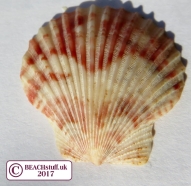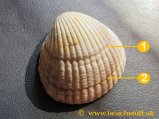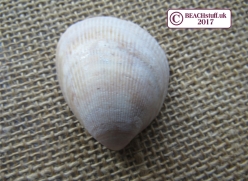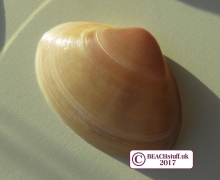

Bi-valve shells
One of the biggest groups of molluscs are known as bi-valves which refers to the fact that each mollusc inside, has two shells (known as valves) to protect it.
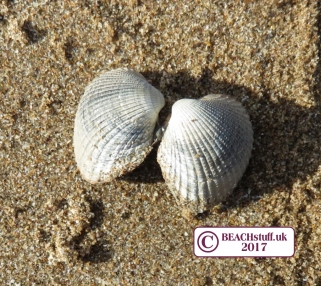 The two hinged shells may be identical, like the cockles above or non-dentical like the scallops below:
The two hinged shells may be identical, like the cockles above or non-dentical like the scallops below:
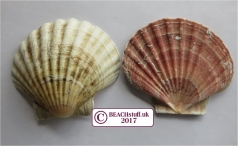
The clam inside holds its two shells (or valves) together so that it is protected inside.
Often, of course, we only find one of the shells on the beach, the other having become detached and lost or broken off.
Have a browse down the page or skip straight to the ones you are looking for:
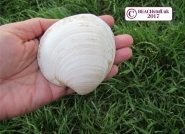
When bi-valves bite back!
Many of our marine birds are very partial to a bi-valve, particularly birds like the oyster catcher. But perhaps, despite the difference in size, and their fearsome shell-opening beaks, perhaps the birds don't always come out on top.
Here's a link to a very interesting article about how bivalves may be able to close their shells onto the beaks of sea birds, effectively starving them to death.
And if this has piqued your interest in David and Goliath type stories have a look at the snail fighting back against the snail-eating beetle.
The largest scallop shells we tend to find are the Great scallops on the left which have odd valves - one flat (on the right), one convex.
Top row below: left - Queen Scallop; middle - Humpback scallops (they look like they've been half melted); right - Variable or variegated scallop (they come all all manner of colours but are distinguishable by having an asymmetric 'bowtie' at the base of the shell)
Bottom row: Tiger scallop
Oysters have much less regular shapes than scallops which can sometimes leave us scratching our heads.
Left: Flat oyster
Below, top row: L: Common oyster; middle: Saddle oyster (found in beautiful bronzes and purples and often adorn my Christmas tree...). R: Little saddle oyster
Below, bottom row: Pacific oyster
Cockles live buried in the sand or silt around much of our coast and so their shells are frequently found washed up.
Their shells are made of two identical halves which are hinged at the narrowest point of the shell and often found together.
They have a single 'foot' which they can use to 'jump' by bending and staightening it skillfully.

Cockles have two identical shells (often found still attached to each other) which are hinged at the narrowest point of the shell.
Above: common cockle
Below: left - rough cockle, middle - prickly cockle (and they really are prickly), right - smooth cockle (also known as a Norway Cockle - common there, but also common in much of the UK coast)
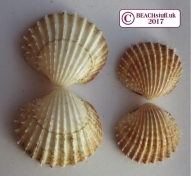
A common cockle feeding. It has two syphons (which we can see from the frills around the top edges). One syphon takes in water, the cockle then takes out all the floating plankton from the water, and spits out the water through the other syphon. It does this from the relatively safe position of being buried in the sand.
Dog cockle
Despite its name, this clam is not related to the cockles above (nor is it related to dogs!). This mollusc lives burrowed in gravelly sand out at sea. Below is a dog cockle feeding. Like the cockles above. the dog cockle feeds through two syphons. In this photo, the syphons are fused together and stretched right out looking like a long white tongue.

The venus clams are the largest mollusc family in the world with about 500 different species. They are generally edible for humans.
On the left is a Striated Venus or Striped Venus. Below left is a Manila Clam. Below right a Warty Venus.
Bottom is a clam feeding with its syphons out ready to take in water.



Hard-Shelled Clam
This clam can look very similar to the Venus Clams and so can be pretty tricky to differentiate from them. It has a thick, robust shell, hence its name.
It was originally a North American species but has found its way to England.
Below, it is feeding with its two syphons out filtering the goodness out of the water.
.
Piddocks
The piddock is an amazing creature. It burrows its way into rock (or wood) by using the rough edge at one end of its shell (the left in this photo). It moves its foot back and forth to rub the shell against the rock until it has made a hole big enough to fit itself snuggly into and then it spends the rest of its life hiding there.
Banded wedge shell
This delicate purple-cream shell is often beautiful pinky-purple inside. The snails like to live buried in the sand.
Spoon clam
A white patternless shell which is extremely thin and fragile - thinner than the tellins. The 'spoon' name comes from the hinge of the shell where there is the tiniest little spoon-shape part of the shell sticking up.

Faroe Sunset Shell
Want to know what a Faroe sunset looks like without having to journey up north?* Look no further. These shells have the radiating colours of sunset and a particularly distinctive sharp crease on one side.
*You may need to use quite a lot of imagination too.


Rayed Mactra
Don't let the fact that Mactra is an anagram of Tarmac put you off - these shells are actually very delicate. They are about the thickness of tellins with stripes radiating from the hinge point. These clams bury themselves but not very deep at all as they have particularly short syphons.
aka Rayed Trough Shell
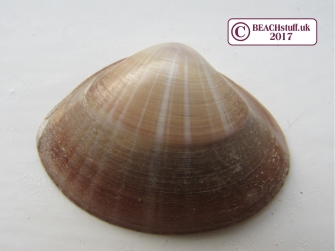
Blue Mussel
The blue-black mussel shell is a common find on many beaches as it likes to live in large colonies on rocks between low and high tide.
Below are the two mirror-image shells of the mussel.
Large mussels are often known as clappy-doos, especially in Scotland.

Razor clams
Razor shells got their name because they look something like old-fashioned cut-throat razors. These are a lot less hazardous though. The clam lives buried deep in the sand.
Bean razor clams (or bean solen)
The Bean razor clam is like the razor clam above but shorter and the shell less straight and razor-like. The 'hinge' between the two shells is also much shorter - and situated between a third and half way down the shell.


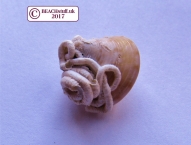
JUST FOR FUN!
Have a go at this ID challenge

Sadly broken but would once have measured about five inches (13cm) across.
SOLVED! Thanks to Jane, who has correctly identified this shell as a Common Otter Shell. Well done Jane!
Any challenges of your own, please send them into hello@beachstuff.uk with photos or post them on The BeachStuff facebook page.


